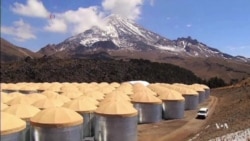American and Mexican scientists have completed construction of the world's largest gamma ray observatory, situated high in central Mexico’s Sierra Negra Mountain. The observatory's huge array of water-based detectors will soon start discovering secrets about black holes and supernovas.
Extreme cosmic events, such as explosions of stars, pulsars or black holes, emit huge bursts of highly-charged particles, called gamma rays, that under certain circumstances can travel faster than the speed of light.
Scientists say the rays are so powerful that some of them can be detected coming from distances up to 10 billion light years away.
Jordan Goodman, a physics professor at the University of Maryland, said, “They are [the] highest-energy light so they let us understand where the highest energy particles in the universe come from. So our idea is to build this observatory to give us a wide field view of the sky at the highest energies.”
Cosmic glow
When cosmic gamma rays hit a medium like water, they create a soft bluish glow called Cherenkov electromagnetic radiation, a glow that can also be seen at the cores of nuclear reactors.
Three hundred tightly-sealed water tanks at the High Altitude Water Cherenkov Experiment observatory, or HAWC for short, also contain sensors that detect and record Cherenkov radiation.
By measuring the angle and intensity at which gamma rays hit the sensors, scientists can calculate where they came from.
Volcanic site
Goodman said along with studying deep space, the new observatory also can study our own star.
“This technique is unusual because someone yesterday, at the conference we had, said, 'you know, we should look at gamma rays from the sun, very high energy.' No one who does a telescope can look at the sun but we can look at the sun because we don't use the daylight, we use the gamma rays,” said Goodman.
The site, at the bottom of an extinct volcano in central Mexico, was chosen for its favorable climate conditions.
After 10 years it will be dismantled and the site's environment will be returned to its original condition.










